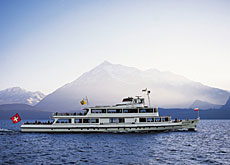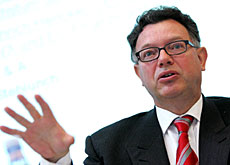Bern bourse has big ambitions

The Bern bourse, which continues to draw growing numbers of small and medium-sized enterprises (SMEs), is slowly emerging from the shadow of the Swiss Exchange (SWX).
After a difficult few years when even its future was in doubt, the Bern eXchange (BX) now has its sights on becoming a “nursery” for the Zurich-based SWX.
“At the time of the merger of the Geneva, Basel and Zurich stock exchanges [in 1995], the Bern bourse decided there was room on the sidelines,” said bourse president Peter Heller. “The needs of smaller Swiss businesses were not going to be served by having just one exchange.”
Ten years and more than a few troubles later, the gamble is on its way to paying off. The BX negotiated the arrival of an electronic trading system in 2002 but has since come under close scrutiny.
At one stage it even looked like the big Swiss banks, such as UBS and Credit Suisse, might withdraw their support but they renewed their backing at the BX’s annual general meeting in March.
The electronic trading platform has proved its worth, according to Heller. The only blip in the bourse’s recent run of good fortune has been a slide of almost seven per cent over the past month, in line with the correction seen in global equities.
Around 50 SMEs are listed on the BX, including companies like Citron, a waste recycling specialist, the financial group BFW, and 3S Swiss Solar Systems.
A number of bigger fish are expected to join, among them Biella, the leading Swiss manufacturer of office furniture. The farm machinery group Hochdorf is also waiting in the wings.
“Biella’s announcement has had a positive effect,” said Heller. “And two or three other firms are set to come on board shortly.”
Niche market
The Bern bourse has gone for a niche market: SMEs from all over the country, although the majority are located on Bernese soil.
Last year the market value of companies listed on the exchange stood at SFr11.41 billion ($9.5 billion), compared with the SWX’s more than SFr1 trillion.
According to Björn Zern, editor of Swiss Equity Magazine, the BX has set itself a realistic target. “It is already attracting enough firms that are not based in the canton. Its positioning gives it a good chance.”
Zern says a listing on the Zurich exchange is often too big a step for SMEs. This is due to the regulatory and legal demands, but also for cost reasons – a listing on the SWX costs at least four times as much as a BX listing.
Firms that go for Bern tend to be “SMEs in the process of transition (Biella) or those who are seeking development capital (3S Swiss Solar Systems), he adds.
“A company can spend two, five or ten years on the Bern bourse and then enter the SWX once it has done its apprenticeship or feels the time is right,” explained Heller.
“Nursery”
The BX therefore sees itself as a sort of “nursery” for the Swiss stock exchange – but one which is also looking to catch the eye of SWX investors.
Zern, however, says the Bern bourse remains a relatively unknown quantity both for potential new listings and for investors. “It needs to sell itself better,” he said.
But as long as the BX keeps its nose clean and in the absence of a major stock market crash, he feels it should strengthen its position on the Swiss capital markets where he says it has a place alongside the SWX.
“It is not in direct competition with us, because it attracts more or less local firms,” said SWX spokesman Jürg Von Arx.
Zern believes that if the BX doesn’t succeed in going it alone, a future tie-up with the Zurich exchange would be an alternative, in line with the European trend towards stock market mergers.
This is undoubtedly a bit premature in view of Heller’s desire to go it alone but the BX president admits that the two bourses are in contact.
swissinfo, Pierre-François Besson
The Bern bourse dates back to 1884.
Electronic trading arrived in 2002.
Ten banks are members of the BX, including UBS, Credit Suisse Private Banking and ABN AMRO Bank.
50 firms are listed on the BX.
Its market value of listed companies in 2005 was SFr11.41 billion ($9.5 billion).
The SWX stood at over SFr1 trillion last year.
In Switzerland share trading is dominated by the Zurich-based Swiss Exchange (SWX), which was formed in 1995 through the merger of the Basel, Geneva and Zurich stock markets.
The SWX and the Bern eXchange (BX) are controlled by the Federal Banking Commission and the stock exchange legislation of 1995.
This law aims to guarantee the efficiency, liquidity, transparency and security of the capital markets. It is supposed to protect investors and fix conditions to allow for the best possible allocation of resources.

In compliance with the JTI standards
More: SWI swissinfo.ch certified by the Journalism Trust Initiative










You can find an overview of ongoing debates with our journalists here . Please join us!
If you want to start a conversation about a topic raised in this article or want to report factual errors, email us at english@swissinfo.ch.